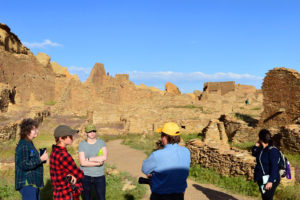
Photo: Elena Jiménez
Highlands anthropology professor Warren Lail, center, talks about the Pueblo Bonito archaeology ruin at Chaco Canyon, New Mexico with students Jennifer Hanisch, Maysie Bucklin, Virginia Bibb, and Marissa García.
Las Vegas, N.M. – New Mexico Highlands University students explored some of the most famous Native American archaeology sites in the world like Chaco Canyon and Mesa Verde during a summer field experience.
The students in anthropology professor Warren Lail’s course, World Heritage Archaeology of the American West, experienced 13 sites in 17 days, from soaring cliff dwellings to ceremonial underground kivas and petroglyphs with astronomy features.
“One of the things that makes Highlands special is its close proximity to incredible archaeology wonders like Chaco Canyon in northwestern New Mexico and Mesa Verde in southwestern Colorado that provide our anthropology students with the opportunity to explore and learn about ancient Native American civilizations firsthand,” Lail said. “With this kind of experiential learning, the students walk the same paths as the ancients did, see the world they lived in, and touch the ruins built thousands of years ago.”
Lail said Chaco Canyon is one of the most famous archaeological architectural ruins in the world, a pueblo civilization that flourished between A.D. 900 and 1150 during the pre-Columbian era. He said Mesa Verde has the largest concentration of cliff dwellings anywhere in the United States, dating back to A.D. 600.
“Chaco Canyon and Mesa Verde are spectacular and are United Nations Educational, Scientific and Cultural Organization, UNESCO, Archaeological World Heritage sites,” said Lail, who also serves as interim dean for the College of Arts and Sciences at Highlands.
He said field experiences like this course are important because they help students understand and appreciate the complex lives of ancient Native Americans.
“The students learn about how the ancient puebloan peoples adapted to their harsh environments with ingenuity and creativity,” Lail said.
Elena Jiménez, an anthropology junior, is one of the six students who participated in the field experience.
“The size and scope of the archaeological ruins we saw like Mesa Verde and Walnut Canyon were breathtaking in person,” Jiménez, 22, said. “It’s extraordinary to see the capacity of ancient humans to build these magnificent structures without using modern tools and technology.”
Jiménez said archaeology is a discipline that requires field work because you can only learn so much from a classroom or textbook. She said it’s vitally important to protect and maintain the archaeological treasures studied in the field course because they are the history of humankind.
“I’m so grateful that I’ve had these kinds of opportunities at Highlands to explore my chosen field as an undergraduate. Dr. Lail is inspiring because he clearly is doing what he loves and is so generous with sharing his vast knowledge. He and the other anthropology professors make you feel like you have an ally that is rooting for you to succeed,” Jiménez said.
Other UNESCO World Heritage sites included in the field experience are Grand Canyon National Park in Arizona and Yosemite Valley National Park in the Sierra Nevada Mountains of Northern California.
The Highlands students also explored significant archaeological sites like Walnut Canyon near Flagstaff, Arizona, Capitol Reef National Park in Utah, and Newspaper Rock State Historic Park near Moab, Utah.
“Another benefit of this field experience is that students gain valuable life experience such as teamwork through camp chores like cooking, pitching tents, and building camp fires,” Lail said.
Lail and his students also visited museums at each archaeological site, studying artifacts from the ruins from pottery to stone and bone tools, basketry and bead work.
